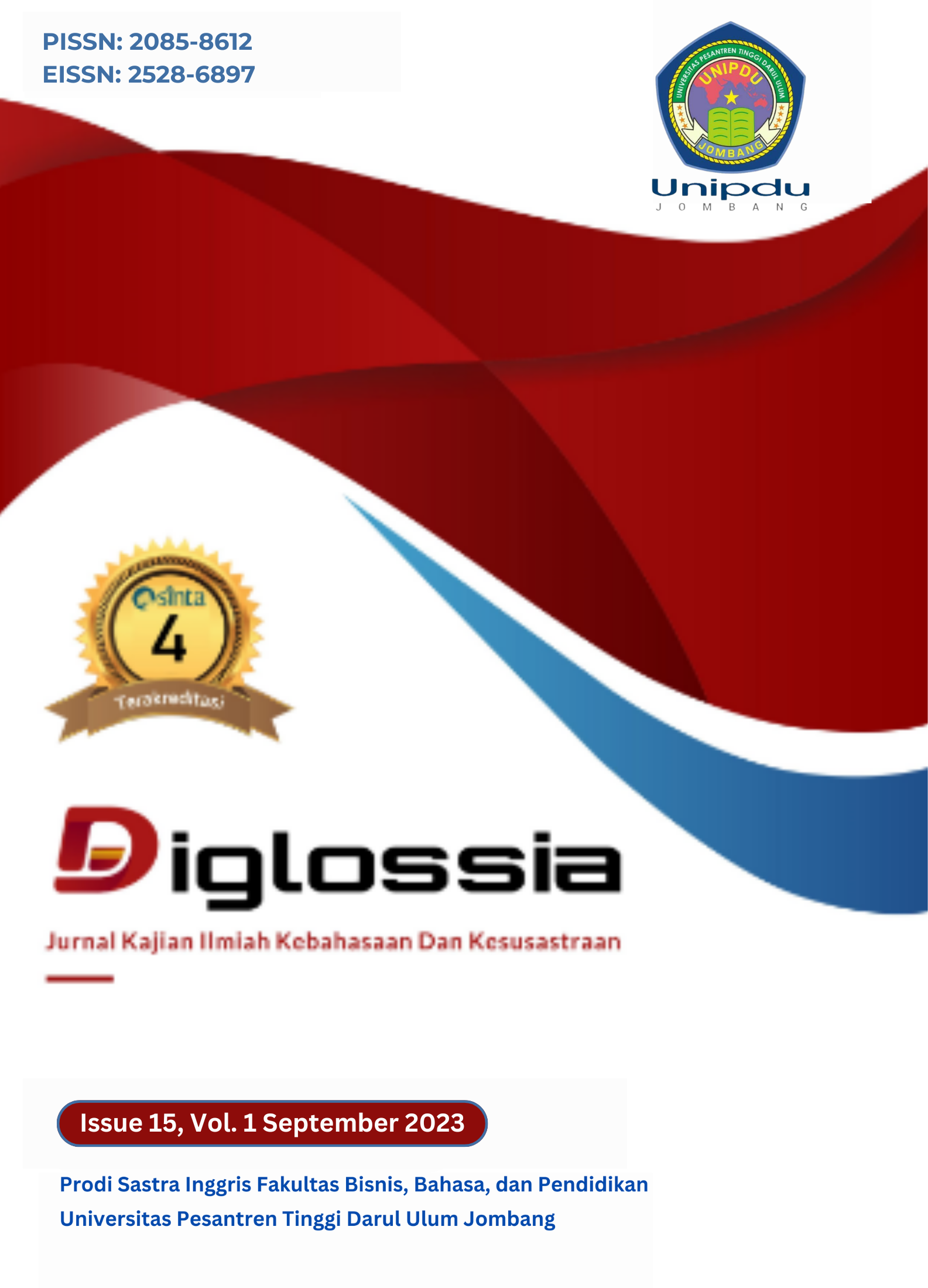Song Translation of Speechless by Naomi Scott: Metaphor and Untranslatability
DOI:
https://doi.org/10.26594/diglossia.v15i1.3356Keywords:
untranslatability, metaphor, translation loss, compensationAbstract
Song is an expressive text which is not an easy task to translate. Many considerations must be taken in order to create a well-produced song translation. In defining the song’s meaning, many procedures are needed to be done. Metaphor and untranslatability need to be presented as the analysis of the song translation. Metaphor which employs hidden and deepen meaning of a text comes along with the song’s expressive feature as a tool to deliver the writer’s feeling and emotions. Translation loss in metaphorical text is also presented while untranslatability deals with the linguistics, cultural, and compensation value of the text. The method used in this research was qualitative descriptive methodology. Metaphorical analysis was done to scrutinize the unseen feature of the text’s meaning. Translation loss in metaphorical view is also being presented in order to reveal the equivalence and inequivalence of the song translation. Two kinds translation loss are found, inevitable and avertable. Untranslatability dealt with the song’s linguistic and cultural phenomenon such as alliteration, assonance, and rhyme. Compensation which deals with untranslatability is also explained in this paper. Compensation in Kind, Compensation in Place, and Compensation in Merging are used to deal with the translation loss of the metaphorical sense of the song.
References
Bassnett, S. (1991). Translating for the theatre: The case against performability. TTR: Traduction, Terminologie, Rédaction, 4(1), 99–111.
Catford, J. . (1965). A Linguistic Theory of Translation. http://books.google.com/books?id=ukUwmgEACAAJ&pgis=1
Harvey, K. (1995). A descriptive framework for compensation. The Translator, 1(1), 65–86.
Harvey, K. (1998). Compensation and the brief in a non-literary translation: Theoretical implications and pedagogical applications. Target. International Journal of Translation Studies, 10(2), 267–290.
Harvey, S., & Higgins, I. (1992). Thinking translation. London: Routledge.
Hendra, H. (2019). Translation Strategy on “Let It Go” Songs That Was Sung By Idina Menzel With Indonesian Version. Journal of English Language Teaching and Literature (JELTL), 2(2), 101–109. https://doi.org/10.47080/jeltl.v2i2.622
Kennedy, X. J., Gioia, D., & Stone, D. (2013). Literature: An introduction to fiction, poetry, drama, and writing. Pearson.
Lakoff, G. (1993). The contemporary theory of metaphor.
Low, P. (2016). Translating Song. In Translating Song. https://doi.org/10.4324/9781315630281
Nababan. 2008. Penerjemahan dan Budaya. http://www.proz.com/doc/2074.
NDRAHA, L. D. M. (2018). The Analysis Of Metaphor In Westlife’s Song Lyrics. JURNAL EDUCATION AND DEVELOPMENT, 3(1), 79.
Newmark, P. (1988). A textbook of translation (Vol. 66). Prentice hall New York.
Nida, E. A. (1991). Theories of translation. TTR: Traduction, Terminologie, Rédaction, 4(1), 19–32.
Sankaravelayuthan, R., & Vidyapeetham, A. V. (2020). Lexical Gaps and untraslatability in Translation. 20(June), 56–82.
Stiasih, Y. (2013). an Analysis of Compensation Techniques for Translation Loss and Captioning Guidelines in Merantau Subtitle. Passage, 1(3), 57–70.
Susanti, M. (2017). Vivid: Journal of Language and Literature Untranslatability Found in J.K. Rowling’s English Novel Harry Potter and The Sorcerer’s Stone and Its Indonesian Version. Vivid: Journal of Language and Literature, 6(2), 0–4. http://jurnalvivid.fib.unand.ac.id
Tiwiyanti, L., & Retnomurti, A. B. (2017). Loss and Gain in Translation of Culture-Specific Items in Ahmad Tohari’s Lintang Kemukus: A Semantic Study. Lingua Cultura, 11(1), 1–6.
Tracy, N., Mustofa, M., Effendi, E., & Nadzifah, W. (2021). Figurative Language in Speechless Song by Naomi Scott: What Meaning Lies Behind It? INTERACTION: Jurnal Pendidikan Bahasa, 8(2), 174–183.
Weiner. The Oxford English Dictionary. Oxford: Clarendon Press, 1989
Downloads
Views: 567 | Downloads: 558
Published
How to Cite
Issue
Section
License
Copyright (c) 2023 Diglossia: Jurnal Kajian Ilmiah Kebahasaan dan Kesusastraan

This work is licensed under a Creative Commons Attribution 4.0 International License.
- Authors who submit a manuscript to this journal and accepted for publication, copyright of the article shall be assigned to the authors of the article.
- Copyright encompasses exclusive rights to reproduce and deliver the article in all forms and media, including reprints, photographs, and any other similar reproductions, as well as translations. The reproduction of any part of this journal, its storage and transmission of databases by any forms or media, such as electronic, mechanical copies, photocopies, and recordings will be allowed by Diglossia
- Editorial Board of Diglossia tries to make every effort to ensure that no wrong or misleading data, opinions or statements be published in the journal. The contents of the articles published to Diglossia are sole and exclusive responsibility of their respective authors.
- The copyright form should be filled with respect to article and be signed originally and sent scanned document file (softcopy) and the article to our email, jurnal.diglossia@fbs.unipdu.ac.id or sent it to the Editorial Office in the form of original hard copy and the article in softcopy form on Flash Disc or Compact Disc, to;Diglossia: Jurnal Kajian Ilmiah Kebahasaan dan Kesusastraan
Prodi Sastra Inggris Fakultas Bisnis dan Bahasa
Universitas Pesantren Tinggi Darul Ulum
Kompleks Pondok Pesantren Darul Ulum
Rejoso Peterongan Jombang Jawa Timur 61481

